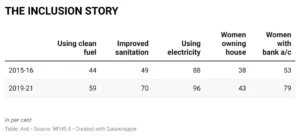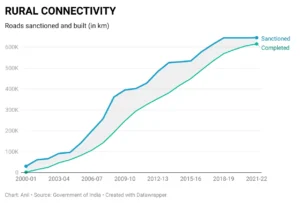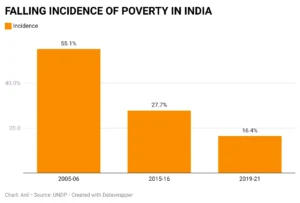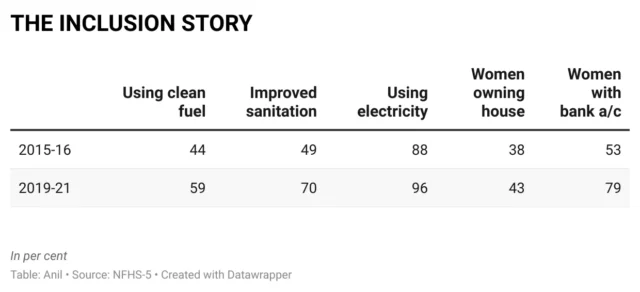NEW DELHI: Addressing the ‘Global Business Summit’ hosted by The Economic Times last week, Prime Minister Narendra Modi claimed that appropriate policy action had enabled India to transform into an ‘antifragile’ nation.
“The world has changed, global systems have changed, and India has also changed. In the recent past, we all have heard a lot of discussions around the interesting concept of ‘anti-fragile’. You are global leaders of the business world and are well versed with the meaning and spirit of ‘anti-fragile’: A system that not only combats adverse conditions, but also becomes stronger by using those conditions,” the PM said.
Regardless of whether you agree or disagree with the PM’s claims, it is a fact that India staged a remarkable rebound in the post-Covid phase. It has baffled both critics and experts alike.
Especially since this recovery is against the backdrop of unprecedented circumstances. The Covid-19 pandemic, which had dodgy origins in Wuhan, China, was followed by an oil price shock. This disruption in global supply chains suffered a fresh setback after the breakout of the Russia-Ukraine conflict.
The acceleration in inflation across the world, especially in the United States, forced central governments to tighten money supply by a rapid increase in interest rates. This, in turn, led to the appreciation of the dollar against most major currencies, including the Indian rupee.
All this did was to export inflation, as importing countries like India witnessed an increase in prices. Making a bad situation worse.
Through all this turmoil the India story was outstanding.
After contracting by a record 23% in the first quarter of 2020-21, the Indian economy rebounded in tandem with the easing of Covid-19 pressure—not only did the virus diminish in strength and spread but also the seamless rollout of the jab created another line of defence.
To cut a long story short, not only did India weather the worst challenge ever but also it is now projected to be the fastest growing economy in the world. Essentially, it benefitted from the turmoil and disorder that has wracked the world—the classic metric of being antifragile.
AntiFragile
The term antifragile was coined by Naseem Taleb. Most of us have heard about this mathematician and former options trader for his cult book—Black Swan—which challenged conventional financial models.
In his book, Taleb walks us through another profound thought: antifragile nations do not wilt in a crisis, neither do they merely weather the story. Instead they thrive in such disorder.
According to him:
“Some things (countries) benefit from shocks; they thrive and grow when exposed to volatility, randomness, disorder, and stressors and love adventure, risk, and uncertainty. Yet, in spite of the ubiquity of the phenomenon, there is no word for the exact opposite of fragile. Let us call it antifragile. Antifragility is beyond resilience or robustness. The resilient resists shocks and stays the same; the antifragile gets better.”
Building Resilience
The big question is whether India has indeed transformed into an antifragile nation? It may still be early days.
Yet it is also a fact, like I explained earlier, that India’s post-Covid recovery has surprised everyone.
My own surmise is that the material basis of India has transformed dramatically as its citizens have undergone an unprecedented trading up.
The first signs of this change were visible in the first decade of this Millennium. The 2001 Census numbers clearly captured this makeover. Yes, it was very basic, but change was happening.
This process acquired unprecedented acceleration in the next decade. Access to banking, toilets, electricity, education, housing, drinking water and roads are nearing saturation levels in the economy.
This change would have been captured in Census 2021. However, the onset of the Covid-19 pandemic in 2020 has forced a delay in conducting the latest Census. As a result, we have to take recourse to official surveys.
The recently released National Family Health Survey (NFHS)-5 is one such survey. It confirms a significant trading up.

In addition, we have data on rural road connectivity. A project that was initiated in 2001 by then National Democratic Alliance headed by Atal Bihari Vajpayee. The project rollout continued under the United Progressive Alliance led by Manmohan Singh. From, 2014, the NDA under the leadership of Narendra Modi accelerated the programme.

This strategy of material empowerment combined with targeted anti-poverty measures—to resolve access to healthcare, hygiene and so on—have helped lower the incidence of poverty in the country. The United Nations Development Programme report (2022) on global poverty, disclosed that between 2005-06 and 2019-21 the number of poor in the country declined by 415 million—which is more than the population of the United States.

Undoubtedly this has transformed the socio-economic backbone of India. Which, I hazard, is what helped the populace mitigate the worst of the Covid-19 fallout. Together, with the strong supply-side policy response, it cemented a surprising rebound of the Indian economy.
And, I would definitely throw in the efficiencies generated by India’s unique digital economy powered by Digital Public Goods (DPGs) like Aadhaar, UPI, CoWin and so on. Not only have they made the economy more efficient, these DPGs have democratised identity, payments, credit and so on. Undoubtedly, it is a force multiplier of transformation.
Whether or not India is antifragile—in the way Taleb coined it—is a matter for economists to debate and slug it out.
But, there is no denying that the material basis of India has altered fundamentally. The frequency of anecdotal evidence backing this claim is only growing. We will have to await the Census numbers to be sure.
Till then let us hang on to this silver lining.
(The author is a columnist and hosts a weekly show called ‘Capital Calculus’ on StratNews Global. Views expressed in this article are personal.)
















